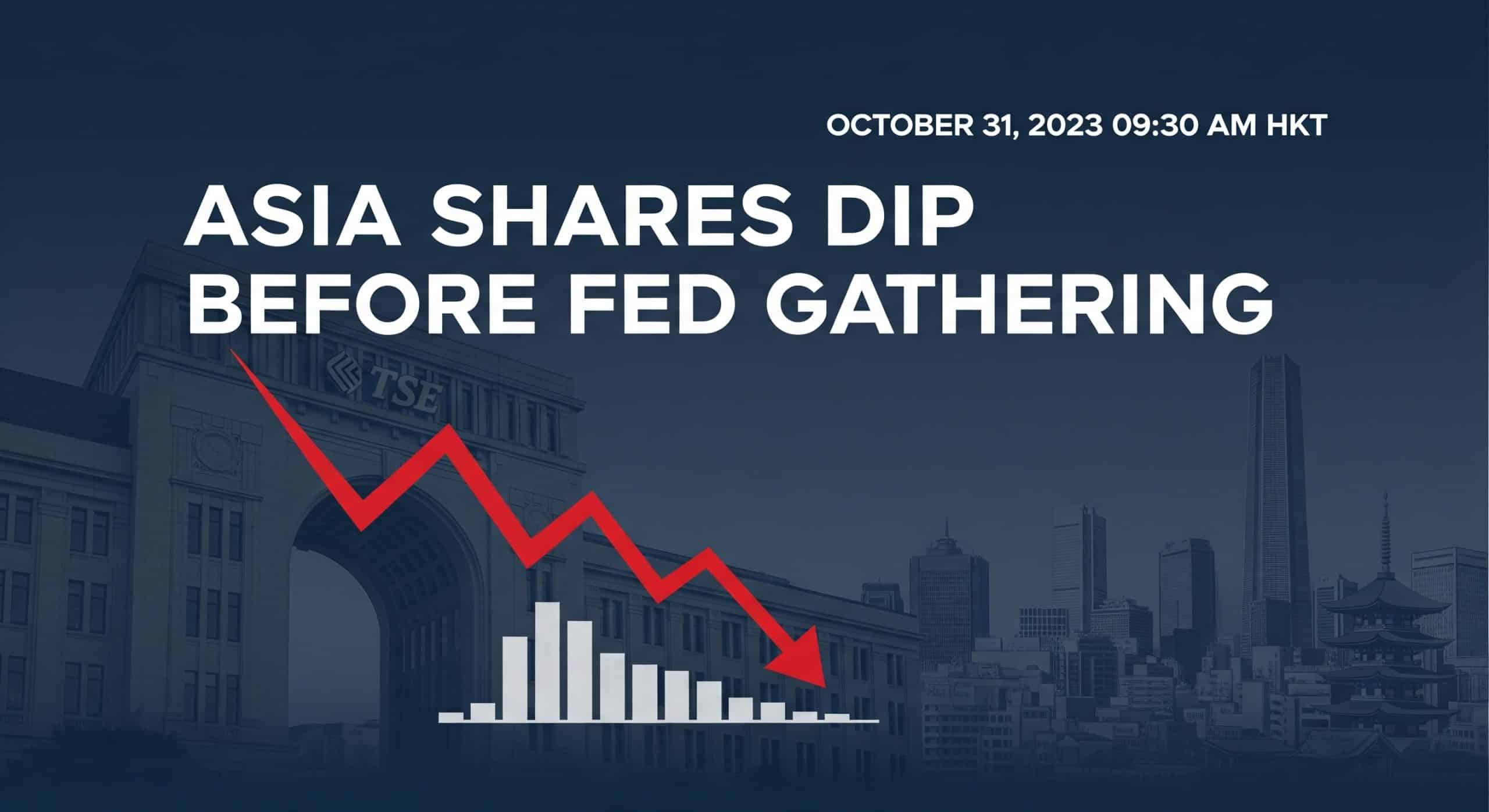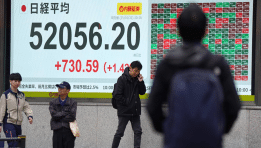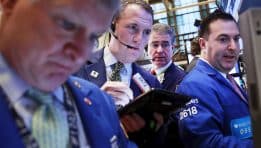
The Impact of Federal Reserve Meetings on Asia’s Market Trends: Analyzing Recent Dips and Future Outlooks
Recent market trends in Asia have faced turbulence, particularly ahead of significant events like the Federal Reserve’s meeting. These meetings, where influential monetary policy directions are set, often create ripples far beyond American shores. Recent data show that many investors in Asia are reacting cautiously as they brace for new insights from the Fed.
One notable aspect is the market’s tendency to dip prior to the Fed gathering. The uncertainty surrounding interest rate changes can lead traders across Asia to adopt a more defensive stance. When hints emerge about possible shifts in U.S. interest rates, markets in Hong Kong, Tokyo, and Shanghai often reflect this unpredictability. Anticipated adjustments, whether increases or decreases, can significantly influence investment strategies in these regions.
For instance, just before a recent meeting, shares in Asia dipped modestly. This decline was not unusual—history shows that trading often slows as investors process potential outcomes and analyze economic indicators leading up to the Federal Reserve’s decisions. Economic stability and growth projections from the U.S. can either buoy or weigh down markets around the globe, depending on the expected ramifications of Fed policy.
On the flip side, while Asia’s markets experience dips, European futures have shown resilience. In light of the ongoing geopolitical situation—especially concerning Ukraine—investors have expressed hopes that summit discussions could usher in stability. This perception adds to a fascinating contrast between the markets; while Asia’s indices may falter, optimism in Europe fosters a different trading mentality.
Another critical factor to consider is how perceptions of inflation influence market behaviors. High inflation pressures remain a hot topic, with many investors keenly analyzing how the Fed addresses the issue in its meetings. If the Fed signals aggressive measures to combat inflation, Asian markets might react with another dip, reflecting overall nervousness about economic conditions.
Key indicators investors should monitor before and after Federal Reserve meetings:
-
Interest Rate Projections: Announcements on whether rates will rise or fall.
-
Economic Development Indicators: Reports on employment, wages, and overall economic growth rates.
-
Inflation Data: Information regarding consumer prices that influences Fed policy decisions.
-
Global Market Reactions: How European and American markets respond, which creates a trickle-down effect on Asia.
Different sectors in Asia also react variably. Tech stocks, for instance, might face steeper declines due to their dependency on interest rates. Conversely, consumer staples often display more stability during these undulating market phases. This variability showcases the complexities of investor sentiment across the continent.
As market participants analyze the coming months, they should be aware of the crucial link between the Fed’s decisions and their implications. How the Federal Reserve chooses to navigate these turbulent economic waters will offer vital indicators for the future. A balanced approach that manages inflation while supporting growth may uplift Asian markets. On the contrary, aggressive tightening could lead to further downturns.
Furthermore, international trade agreements and political stability in regions like Asia can substantially alter market dynamics. Investors must remain vigilant, as geopolitical tensions can once again skew market responses. Proactive strategies, including diversification and assessing emerging market opportunities, can buffer against potential volatility instigated by Federal Reserve policy changes.
Monitoring the Fed’s decisions is imperative for investors connected with Asia’s markets. While recent dips before Fed meetings present challenges, optimistic signals from European futures reflecting hopes regarding geopolitical dialogues might inspire strategies that lead to recovery. By staying informed and strategically agile, investors can better navigate these complex financial waters.
European Market Reactions: How Ukraine Summit Developments Influence Future Investment Strategies
The European financial markets are experiencing a notable shift as they react to developments surrounding the Ukraine summit. This high-stakes meeting is not just a political event; it’s influencing investment strategies across the continent and beyond. Investors are closely monitoring the situation, and it’s essential to understand how these dynamics play out in the broader market context.
Recent tensions in Eastern Europe have caused significant fluctuations in the financial landscape. Many investors are looking for opportunities amid uncertainty. Some might retreat from risky assets, while others see this as a chance to invest in undervalued sectors. Understanding how these sentiments evolve will empower you to make informed decisions about your investment strategies.
One of the primary factors driving the market response is the anticipated outcomes from the Ukraine summit. The potential for diplomatic breakthroughs or intensifying conflict can both influence market sentiment. Here’s how various factors interact:
-
Political Stability: If the summit leads to a peaceful resolution or new agreements, expect a surge in market confidence. Stocks may rally, particularly in sectors linked to trade and energy.
-
Investor Sentiment: Increased optimism typically leads to more inflows into European markets, especially from foreign investors. Conversely, a pessimistic outcome could lead to declines.
-
Commodity Prices: Developments from the Ukraine summit can affect key commodities like oil and natural gas. Fluctuations in prices can reshape investment priorities, especially in sectors heavily reliant on these resources.
The reaction of Asian markets leading up to the summit serves as a barometer. When Asia shares dip before significant events, it often indicates a cautious approach toward investing. In this case, European stocks could rally if analysts predict positive news from the summit.
The dynamics of the Ukraine situation do not just affect immediate responses; they also have long-term implications. Investors may begin to consider how geopolitical stability influences their portfolios over time. Adopting a long-term view can help make smarter, more strategic choices that go beyond short-term volatility.
The ongoing conflict has also highlighted the importance of diversification in investment strategies. As tensions rise, sectors such as defense and energy may see increased allocations. Meanwhile, industries heavily reliant on trade routes may face increased risks. It’s crucial to assess portfolios and identify areas for adjustment in light of these geopolitical developments.
Additionally, those involved in technology investments should consider how the Ukraine summit could shape regulations surrounding cybersecurity and data protection. As threats evolve, expectations for compliance might shift dramatically, impacting tech valuations and investment landscapes.
Strategies to consider:
-
Stay Informed: Keep a close eye on news coverage related to the Ukraine summit.
-
Diversify Investments: Look for opportunities across sectors and geographic locations to hedge against downturns.
-
Evaluate Risk Tolerance: Amid uncertainty, assess your risk appetite and adjust your portfolio accordingly.
The influence of the Ukraine summit on European markets is multifaceted, impacting stocks, bonds, commodities, and beyond. As developments unfold, remain agile in your investment approach. The more actively you engage with unfolding events, the better positioned you will be to seize opportunities.
European markets will continue to react strongly to the outcomes of the Ukraine summit and other geopolitical developments. By staying informed and adaptable, you will find the best opportunities to capitalize on market shifts.
Conclusion
Understanding the dynamics at play in the current market landscape is crucial for investors and traders alike. The recent dips in Asia’s share markets highlight the significant influence of Federal Reserve meetings on investor sentiment and overall market trends. As the Fed navigates its monetary policy, resulting uncertainty can lead to fluctuations that impact stock prices across the Asian markets. Observing these trends enables you to adapt investment strategies responsive to changing economic signals.
Meanwhile, European markets appear to be on a different trajectory, buoyed by hopes surrounding the Ukraine summit. Political developments and discussions on peace agreements can significantly shift market perceptions and risk appetites. As Europe anticipates potential outcomes from the summit, this optimism can directly affect investment decisions and strategies.
Balancing these two perspectives—the cautious approach driven by U.S. monetary policy in Asia and the hopeful sentiments in Europe—offers a complex yet engaging view of the global financial market landscape. By recognizing the interplay between Federal Reserve decisions and international events like the Ukraine summit, you can make more informed choices that align with your financial goals. Proactive and prepared investors will be best positioned to navigate these turbulent times successfully.
Comparison, examination, and analysis between investment houses
Leave your details, and an expert from our team will get back to you as soon as possible
* This article, in whole or in part, does not contain any promise of investment returns, nor does it constitute professional advice to make investments in any particular field.
To read more about the full disclaimer, click here- sagi habasov
- •
- 5 Min Read
- •
- ago 5 hours
 SKN | Lockheed Martin Contract Expansion Signals $10 Billion Boost to US Defense Spending
SKN | Lockheed Martin Contract Expansion Signals $10 Billion Boost to US Defense Spending
The US Department of Defense has approved a significant expansion to an aircraft-related contract awarded to Lockheed Martin, increasing
- ago 5 hours
- •
- 5 Min Read
The US Department of Defense has approved a significant expansion to an aircraft-related contract awarded to Lockheed Martin, increasing
- Ronny Mor
- •
- 5 Min Read
- •
- ago 5 hours
 SKN | Nvidia Shares Climb 3% as Earnings Momentum Reinforces AI-Led Market Leadership
SKN | Nvidia Shares Climb 3% as Earnings Momentum Reinforces AI-Led Market Leadership
Nvidia Corporation closed higher on December 23, 2025, extending its strong performance as investor focus remained firmly anchored on
- ago 5 hours
- •
- 5 Min Read
Nvidia Corporation closed higher on December 23, 2025, extending its strong performance as investor focus remained firmly anchored on
- orshu
- •
- 5 Min Read
- •
- ago 6 hours
 SKN | Nikkei 225 Holds Above 50,400 as Japan Equities Consolidate Near Record Territory
SKN | Nikkei 225 Holds Above 50,400 as Japan Equities Consolidate Near Record Territory
Japan’s benchmark Nikkei 225 ended the December 23, 2025 session slightly higher, closing at 50,412.87, up 0.02%. The muted
- ago 6 hours
- •
- 5 Min Read
Japan’s benchmark Nikkei 225 ended the December 23, 2025 session slightly higher, closing at 50,412.87, up 0.02%. The muted
- orshu
- •
- 8 Min Read
- •
- ago 6 hours
 SKN | US Markets Close Higher as Tech and Large Caps Advance While Small Caps Lag
SKN | US Markets Close Higher as Tech and Large Caps Advance While Small Caps Lag
U.S. equity markets ended the session higher, supported by gains in technology stocks and large-cap benchmarks, while small caps underperformed.
- ago 6 hours
- •
- 8 Min Read
U.S. equity markets ended the session higher, supported by gains in technology stocks and large-cap benchmarks, while small caps underperformed.











